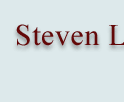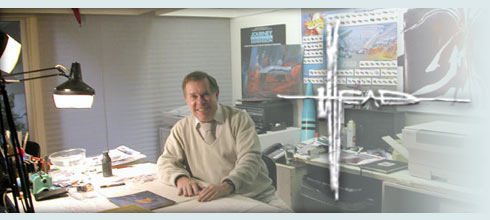 |
|||
 |
|||
 |
|||
 |
TRON - 1982 One of the most groundbreaking movies in movie history. The first serious try to use computergraphics to realize an Idea, an entire film. With help of Syd Meads talent the movie got a timless look and feel. Not many movies reached that Level. |
||
 |
BLADE RUNNER - 1982 This Movie, after the Book „do androids dream of electric sheep“ by Philip K Dick, directed by Ridley Scott is a modern SciFi Classic. Again the noir kind of look of the movie was created by Syd Mead. A remarkable Job to create a such unique World. |
||
 |
2010 - 1984 Peter Hyams continued the fabulous mysterious Story about what happened in Stanley Kubricks Classic 2001. You get a lot of answers but more questions too. Among Syds designs we have Leonov. The russian spacecruiser that brings us into the orbit of Jupiter. To the monolith and the missing Discovery. |
||
 |
ALIENS - 1986 James Cameron lead us to a Queen. Too bad that Queen was an Alien queen. A frightening beauty. We were like banned when we watched those marines fight their way through a rotten futuristic industrial complex. A concept by Syd Mead. |
||
 |
|||
|
Why do i start with the movies? Because we all have seen one or another of these. We are fascinated by the worlds they show us. They open our eyes and widen our horizons. At least, this is what happened to me when i first saw these movies. Syd Mead helped to create these sometimes utterly dark and sometimes wonderfully bright worlds. All the people that work on todays big screen movies as concept artists were most likely influenced by Syd Mead - one of the pioneers in that industry. Movies are not the only thing Syd has done in his long career. He started as a car designer. Moved onto a broader field. Designed ships and yachts for the richest of the rich. Even designed the interrior of a 747 private jet. You know the famous look of the Lockheed F22 Raptor jet that the US Military was testing so long? A design by Syd Mead. A neverending list. A legend. And we are proud to present you this interview to give you a small but nice insight into his world. Enjoy! |
|||
 |
|||
 |
 |
||
Q#1: For everyone that doesn't know the man behind the spectacular pieces you bring to the world, first a little bit about your past and what drew you to this type of thing. How did you grow up and were you always fascinated by drawing/painting something? A lot of popular artists tell us they started very early with drawing and soon found out that they could make a career out of it, did you feel the same way? |
|||
 |
Syd Mead: By the time I was 3 yrs old, I was drawing cars with people waving out the windows. I guess I always associated drawing things with the ‘in situ’ surroundings. To this day, if I draw a car or a design for a client, I usually start with figures. Nothing we use or design exists in a vacuum. By the time I was in the fifth grade (about eleven years old) I was doing intricate ink drawings with an instrument called a crowquill pen, a very delicate line making instrument. At that same age I discovered PRISMACOLOR pencils with a waxy filling. I made lots of drawings of mutated animals and actually got my first fee selling exotic dog pictures to my school mates for 25 cents each. In 1941, that would be, today, with the devalued U.S. dollar, several dollars. It kept me in candy.By the time I was in high school (grade 12) I knew I would make my living creating art. |
||
Q#2: You are well known for your vehicle designs, interior and exterior designs. Which genre do you enjoy most? The creation of wonderfully streamlined, futuristic vehicles? Or is it the design of places people 'could' live in that thrills you? What is your favourite thing? |
|||
  |
Syd Mead: ‘Favorite’ is a strange word. It implies something over something else. To me, my ‘favorite’ thing is the design and drawing procedure itself. I’ve painted horrible designs expertly for interior designers and architects, but I painted expertly. If I must make a choice, it is to paint scenarios that are fantastic, both in the way the occupants are dressed and shown, and the machines, entourage and details that make the finished picture a ‘peek’ into an exotic future that may, or may not ever exist. In other words, I like to create glimpses into a fantastic world that is eclectic (as we become more creative, we learn to appreciate the past with more enthusiasm), egalitarian (personal advancement available to all in a stable, rational society. This social condition is the absolute opposite of the restrictive, pathological insistence typical of both orthodox Jewry and Islamic belief) and the appreciation of technology as a celebration of human intelligence. The futuristic vehicles, the places for people all this is both a joy to depict and a proposal for a future that is bright. This optomism is looked upon by so-called ‘realists’ as frivious. They are wrong. Depicting a bright, pleasant future is a hopeful rehearsal as a model for social advancement. |
||
 |
 |
||
Q#3: Now a question I've been eager to ask for a while now regarding the movie side of things. Back when you worked on 'TRON', it was one of the most groundbreaking movies of that time. A first serious try to create a movie with computer generated images. I'm sure you encountered a lot of problems back then, with what was possible and what was impossible to do with the limited technology made available to you. When you look back from then, to how technology has highly advanced, what do you think about how technology will shape our lives, what will be involved and how it will be implemented into visual media? |
|||
  |
Syd Mead: TRON looks like it does because, simply, that was the absolute ‘cutting edge’ of computer imaging technology at the time. Steven Lisberger has to be admired for pursuing the making of the film, especially because he slipped the production into a window when Disney was in a state of flux. I doubt very much if the executives would have allowed a ‘non hand animated’ film to be produced at their studios had the company been in ‘normal’ management mode. Remember, the Academy of Motion Picture Sciences refused to admit the film into concourse because ‘they’ (Lisberger, at all) used computers!
I designed the various vehicles, set ideas and graphics to reflect what I was told by Lisberger; that shapes had to be relatively simple in a volumetric way. I designed, literally, to the lowest common problem denominator, a classic industrial design approach. The vehicles were three dimensional graphical entities. They couldn’t do my original design for either the LIGHTCYCLE though, because it involved compound, teselated surfaces. The SOLAR SAILOR I designed could not be formed because, again, it was basically a compound curve shape. All of the shapes in TRON were either additive or removed geometric solids, or were formed by extruding a constant section. |
||
 |
 |
||
Q#4: Concept art has been a big part of your career, with movies such as Blade Runner, to animated cartoons and videogames like Wing Commander Prophecy. You've worked for some of the leading Automotive companies, you even designed the interior for a 747 jet! What are the differences on how you approach and work out these projects? I can imagine that, to work out concepts for a movie is slightly different than to work out ideas for a videogame. |
|||
 |
Syd Mead: In my mind, any design project takes on the parameter of a story. Concept art is what I have become known for, an idea that is widely considered in Europe as frivolous. What these humorless pragmatists forget is that inspiration is the first step toward idea, and idea is the first step toward recognizing the desireabilty of the proposed result. The movies are to storytelling what the symphony orchestra is to music, the most elaborate story-telling medium we have available. To work in this industry by invitation multiple times is, to me, a great compliment to me. Practical design - that which ends up on a store shelf, on four wheels, or as an immersive entertainment environment, all are part of their own story. Without some sort of appreciation of ambience, utility matched to elegant solution, designs become mundane. Much of today’s automotive design is, in my view, stiflingly mundane. The visceral response to mechanical challenge essentially disappeared from most automotive design over two decades ago. |
||
 |
 |
||
Q#5: We've asked all the previous interviewees this, it always gets a great answer! What was the funniest thing you've put in an artwork, a mistake that made you angry back then but makes you laugh today? A little insight into what happened? We love to know that even behind the amazing talent, you are still human now and then. |
|||
   |
Syd Mead: I don’t know if it qualifies as ‘funny’ or not, but it DOES come under the heading of saving your ass past the point when you have the time to ‘fix’ it. I was finishing up panel three of a triptych for the 2OOO PEBBLE BEACH CONCOURS d’El’egance. It was beautiful and then a drop of water fell on the airbrushed vehicle I had just finished. Gouache is water soluble. When you airbrush it, you have an extremely fragile surface that can be stained by touching it with your finger, it bruises when pressed on... I was devastated! How could I... I didn’t have the time to correct it so, remembering my rendering instructors from years before, I created a decorative banner to hang gracefully down across the offending spot. It worked perfectly... actually lent a bit of three dimensional lllusion to that part of the illustration.
Another incident. I was working in my beach house studio and one of my agents stopped over to see me. I commonly worked at the same time that I ‘entertained’ friends. He had just bought a new Mercedes and had parked it right below my studio sliding glass window. I had a little step-out balcony. When the landscaping guys came up to mow the lawn, he exclaimed’ “Oh, I hope they don’t scratch my car.” We were drinking beers in mugs. Mine was on the taboret behind me. He had set his down on the front of my table. I had just finished airbrushing a beautiful ceiling on an architectural interior illustration. As he moved quickly to look out the window, he bumped his beer mug. The beer spilled onto my illustration. I immediately tipped the illustration up and away from me, but the ceiling area was ruined. He looked at me and quietly announced; “I think I better leave now.” He did. He later proved to be a total asshole. When a drop of water falls on a gouache surface, the gum Arabic in the gouache sublimates out of solution and forms a ring around the wet spot. It has to be literally sanded down with emery cloth, and then painted over again. The beer incident cost me a half day in repairs, pushing the finishing of the illustration past midnight. |
||
 |
 |
||
|
Q#6: In the early 80s, 'the StarWars era' we'll call it, the whole look of sci-fi kind of changed. StarWars was one of the first sci-fi movies that showed us a 'used' look. They made their world look like it was in use for centuries. Scratches, dust, dirt etc. Before Starwars, all the sci-fi movies looked somewhat, the same. Everything streamlined and clean with reflecting surfaces etc. We know your designs for blade runner (1982), 2010 (1984) alien 2 (1986). Especially in blade runner the design is very weathered... everything kinda has a used, almost rotten, look. Were you influenced by the direction that Starwars pointed to? A more 'realistic' approach...?
(Even in 2010 we see the difference! The Discovery spaceship design (very clean and white) from Kubrick's classic 2001 and your design for the Leonov (used and much more complex). |
|||
   |
Syd Mead: To answer the end of your question first? No. Training and years of creating scenario teaches you to create ambience that compliments the story. (Read previous answer no. ‘4.’) The starwars models were essentially solid models with lots of glued on model kit pieces that gave the surfaces a detailed, ‘must be real’ kind of look. Before the satellite launch era, ‘sci-fi’ was influenced by the romantic notion of streamlined missiles that flew through space. Now, the public is quite aware that a square box can be pushed through the vacuum of space at light speed, if you wish to prove Einstein wrong. Star Wars was the first movie of the ‘sci-fi’ genre to ‘wear’ the stuff. It was terrific. Bladerunner? Philip K. Dick, the author of ‘DO ANDROIDS DREAM of ELECTRIC SHEEP’ was a morose man who attempted suicide several times. His world was dreary, and I helped Ridley Scott create the visually dystopian world that he intended to show. My designs for BLADERUNNER wher influenced by the story, not by star wars.
2OO1 was released before the start of the ‘space age’ technology. It was the last major sci-fi film to retain what I call the ‘GE kitchen of tomorrow’ look; everything shiny white, pristine, slick. The LEONOV in 2O1O reflected the general knowledge that space craft did not have to be shaped like bullets. They could be lumpy, squared off, non-aerodynamic. (The shuttle is a cumbersome, utilitarian designed craft, covered with an arrayof custom shaped ceramic tiles that, up close, resembles a ‘brick airplane.’ It is NOT clean, sleek and even particularly ‘fast’ in the aircraft sense. |
||
 |
 |
||
Q#7: Concept art today is still a mix of traditional execution and digital. Would you say that concept art will soon reach a point where it will be completely made on a computer or do you think that there will always be room for the proven traditional way? |
|||
 |
Syd Mead: Tradition dying out? They still teach Latin! Traditional techniques are the original ways in which art was done. Digital algorithms duplicate, as closely as possible, those ‘classic’ techniques. Corel Painter even simulates the wetness of watercolor. There is, however, a certain delicate tactile interface between traditional ‘tool’ (brush, pencil, pen) that is subtly difficult to reproduce. I have tried a Wacom Cintiq on trial and did not like it. And still, the ‘tool’ doesn’t do anything by itself, unless you are doing fractal run-outs, or algorithmic mathematical run-outs. These can be beautiful, but they do not make a picture of anything. |
||
 |
 |
||
|
Q#8: As the 'godfather' of concept design/art for a lot of people, including me, it is no wonder that you worked on a lot of things over the years. There was no job that you "could not have got done", like you said in another interview. What kind of projects do you enjoy the most and what kind of projects are the most rewarding for you?
|
|||
  |
Syd Mead: When I’m commissioned to work on a project, I’m hired to create a visualized image of what the end result should be look like. Any new challenge to my imagination is exciting, whether a watch (I designed two for NUTS studio in Tokyo: they were the only ones to sell out. We sold four images to be used on a ‘SYD MEAD’ t-shirt line for ADDICT in London. They sold three times their normal ‘name’ line edition.)
So, the thrill is in accepting the challenge of a new kind of design task, watching it become solved to the satisfaction of the client and then moving on to the next. Rarely do I work on the same kind of problem in sequence to a similar previous one. And so, announcing a preference for ‘what kind’ is the incorrect question. The answer is I enjoy the complete range of design activity, from coffee makers to the interiors of supersonic and wide body private aircraft to super yachts to master plans for theme parks. |
||
Q#9: How long does it take you to finish a project? May it be a movie job or interior design for a 747. What steps does a usual job go through, from the beginning to the end? What's the structure of your work process? |
|||
 |
Syd Mead: The time to finish a job obviously is matched to the complexity of the job to begin with, the liason with people who are my client contacts and the distance between our cultural norms and the client’s, if the client is foreign. I have completed a design job within two weeks, and the one I am finishing up now has lasted over four months. My design involvement for the Boeing 747 interior for His Majesty King F’had lasted about eight months, from first illustrations to the plane being delivered to the FAA and the King’s representatives. I will say that because of the complexity of that job, it was at the same time most satisfying and most stressful. |
||
 |
 |
||
Q#10: How do you approach a client? What kind of questions do you ask your client to prepare yourself for the assignment? Questions that help you to understand what the client wants. |
|||
 |
Syd Mead: We are approached by a prospective client. My ‘salesforce’ are the books we publish through OBLAGON, INC. and my world-wide visibility, generated over fifty years at fairly high visibility levels in most of the technologically advanced countries. We have a ‘radar’ system for finding out how viable a prospective client is. They have to have a legitimate design request, have a monetary ability to pay an entrance fee and be in some area that we find interesting to work on. In our contract we demand assurance that all information from client to us is accurate. We have had incidents where information was erroneous requiring corrections after the contracted design work had been done. We are paid a per diem overage in such cases, or we resign the account. |
||
| QUESTIONS FROM SELECTED PEOPLE ACTIVE ON DEVIANTART.COM | |||
HIDEYOSHI (http://hideyoshi.deviantart.com): What's your view on digital tools like Photoshop or Painter? We don't see you using them that often or at all. Instead, much of your works are done traditionally with Gouache. Have you tried to paint digitally with a graphic tablet like Craig Mullins for example chunking out finished renderings/paintings? |
|||
 |
Syd Mead: Digital tablets are excellent for adjusting, filling in or tracing on existing artwork. Corel or Adobe has a wide variety of filters and shaders for creating marvelous digital matte shots. Yes, you can import Alias or Maya images and retouch them. Here’s the thing. I am paid to be at the front end of projects. I am hired for new ideas. For that purpose, quick use of ink drawings and felt tip pen shading is entirely sufficient. If this still works on 15O million dollar movie production, I’m still in the loop. |
||
CONCEPT-ON-MAC (http://concept-on-mac.deviantart.com): How do you feel about being the sole reason for a lot of artists wanting to be concept designers and how do you think the role of the concept artist has changed over the years since you started working in the industry? |
|||
 |
Syd Mead: A concept artist is a different kind of activity from a concept designer. I called myself a concept designer because I went through the classic INDUSTRIAL DESIGN education process, AND I knew how to expertly illustrate to a photographic reality level. The role of the concept artist has changed little, since the artistic skill is mental; the tools used depend on the level of tool sophistication at any point. Concept art and concept design are not tool dependent as a mental activity. Production of the image for display is very tool dependent in order to ‘fit into’ the display modes of the day. |
||
 |
 |
||
PSHEM (http://pshem.deviantart.com): Where did you find the inspirations for basic shapes of vehicles and architecture for blade runner for example. Does it have its origins in some science publications or did they just came to your mind like "that would look neat here or there"? Were you influenced by stanislaw lem's work on the one or another work you did? |
|||
 |
Syd Mead: Inspiration generates from story. In the case of a movie, the story is defined by the script. I caught on early in the process that Ridley wanted to make a dark (use the term ‘noir’ if you think you speak French) story based on Phililp K. Dick’s book. That story was dark, which is why Ridley liked it.
The impetus for the elaborately collaged architectural style simply was a way to make the street sets look compressed and cluttered. I received no visual cues from any sci-fi illustrations, as most of them are aimed at a rather juvenile appreciation level, or are expertly done for a niche preference that does not match what I’m expected to create. |
||
CQ: As a concluding question on our little journey through your world... are there any wishes, dreams for your career/life left? Something you had no chance to do so far. Maybe a dream project? What can we expect next from syd mead? |
|||
 |
Syd Mead: I have worked on many designs for cruise ships and super yachts. The first was an 8OO foot long proposal for Norwegian Carribbean Lines back in 1973. The next one was a 4OO+ long yacht for Adnan Kassoggi. That was never built because Adnan got into trouble here in the U.S., was briefly jailed and then allowed to leave the country. The next was a series of super yacht proposals for mid eastern sheiks. Those deals can be unpredictable sometimes. Then, it was a 15O foot SES (surface effect ship) design for a guy in New Orleans. The next one was a proposal for a 4OO+ plus foot yacht for Donald Trump. That was cancelled when 'The Donald's' checkbook was taken away from him as a result of the Taj Mahal casino deal in Atlantic City and his divorce from Ivana. THEN, there was the DEFINITIVE design for the Tencara Yacht group in Venice, Italy. The proposed client was the Rothschild Group. They failed to put the necessary millions on deposit in London, and the first keel order was canceled. I don't swim. Perhaps Triton, the god of the sea, is pissed at me? I would LOVE to have an advanced design of mine launched!
|
||
 |
|||
 |
|||
 |
|||
We want to thank Syd for his time answering our questions! It was very informative and interesting to read what a true long time professional of both concept design and concept art has to say about his work and the industry itself. We wish you good luck on all your upcoming jobs Syd, and hope you will have a lot of fun. We can't wait to see what comes next from you and your wonderful imagination. We're watching you...! |
|||
 |
|||
all images used for this interview are copyrighted by either syd mead or tigaer-design.com.
all text is copyrighted by tigaer-design.com and may not be used without permission.